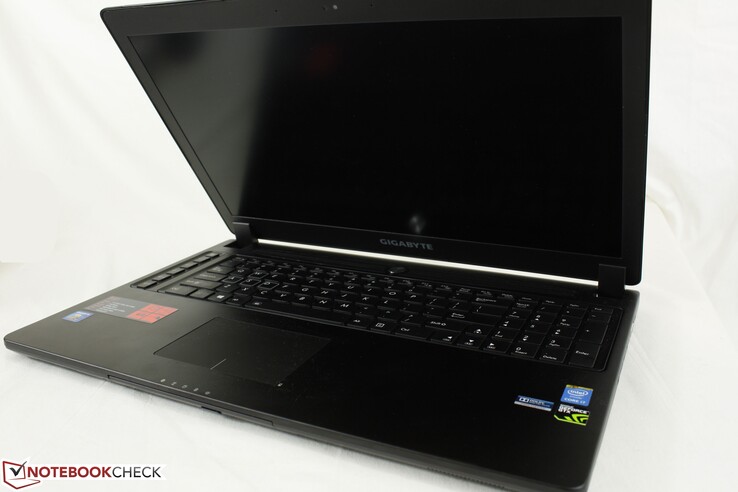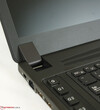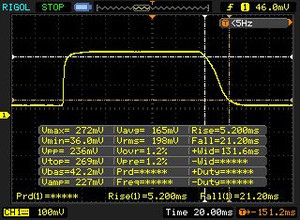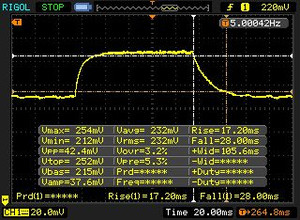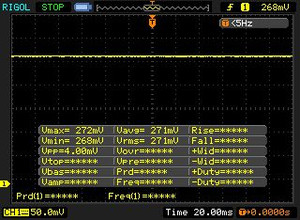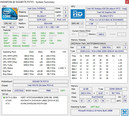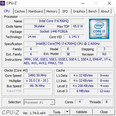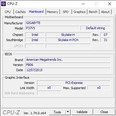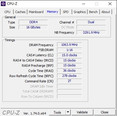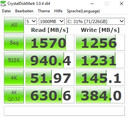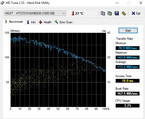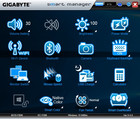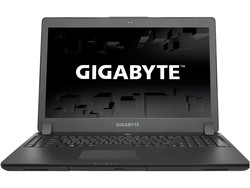Breve análisis del Gigabyte P37X v5
| |||||||||||||||||||||||||
iluminación: 89 %
Brillo con batería: 306 cd/m²
Contraste: 729:1 (Negro: 0.42 cd/m²)
ΔE Color 3.51 | 0.5-29.43 Ø5
ΔE Greyscale 2.23 | 0.57-98 Ø5.3
85% sRGB (Argyll 1.6.3 3D)
56% AdobeRGB 1998 (Argyll 1.6.3 3D)
62.2% AdobeRGB 1998 (Argyll 2.2.0 3D)
85% sRGB (Argyll 2.2.0 3D)
67.4% Display P3 (Argyll 2.2.0 3D)
Gamma: 2.51
Top 10 Análisis
» Top 10 Portátiles Multimedia
» Top 10 Portátiles de Juego
» Top 10 Portátiles de Juego ligeros
» Top 10 Portátiles Asequibles de Oficina/Empresa
» Top 10 Portátiles de Juego Ligeros
» Top 10 Portátiles de Oficina/Empresa Premium
» Top 10 Estaciones de Trabajo
» Top 10 Subportátiles
» Top 10 Ultrabooks
» Top 10 Convertibles
» Top 10 Tablets
» Top 10 Tablets Windows
» Top 10 Tablets de menos de 250 Euros
» Top 10 Phablets (>5.5")
» Top 10 Smartphones
» Top 10 Smartphones (≤5")
» Top 10 Smartphones de menos de 300 Euros
» Top 10 Smartphones de menos de 120 Euros
» Top 10 Portátiles de menos de 1000 Euros
» Top 10 Portátiles de menos de 500 Euros
» Top 10 Portátiles de menos de 300 Euros
» Los Mejores Displays de Portátiles Analizados por Notebookcheck
| Gigabyte P37X v5 LP173WF4-SPF1 (LGD0469) | MSI GS70-6QE16H21 Chi Mei N173HGE-E11 (CMN1735) | SCHENKER XMG P706 LG LP173WF4-SPD1 | Alienware 17 R3 (A17-9935) CV69H_173WF4 (LGD0459) | Gigabyte P37X LG Philips LP173WF4-SPF1, ID: LGD0469 | Gigabyte P35X v5 SHP144E | |
|---|---|---|---|---|---|---|
| Display | 7% | -1% | -1% | 3% | 6% | |
| Display P3 Coverage | 67.4 | 67 -1% | 66.9 -1% | 66.9 -1% | 68.7 2% | 64.8 -4% |
| sRGB Coverage | 85 | 97.3 14% | 84.6 0% | 83.9 -1% | 87.9 3% | 95.8 13% |
| AdobeRGB 1998 Coverage | 62.2 | 67.6 9% | 61.8 -1% | 61.4 -1% | 64 3% | 66.9 8% |
| Response Times | 20% | -33% | ||||
| Response Time Grey 50% / Grey 80% * | 45 ? | 33 ? 27% | 51.2 ? -14% | |||
| Response Time Black / White * | 26 ? | 23 ? 12% | 39.2 ? -51% | |||
| PWM Frequency | 200 ? | |||||
| Screen | -1% | -10% | -9% | -4% | -28% | |
| Brightness middle | 306 | 172 -44% | 306 0% | 360 18% | 361.7 18% | 278.9 -9% |
| Brightness | 294 | 161 -45% | 302 3% | 336 14% | 347 18% | 272 -7% |
| Brightness Distribution | 89 | 85 -4% | 90 1% | 90 1% | 91 2% | 80 -10% |
| Black Level * | 0.42 | 0.26 38% | 0.34 19% | 0.44 -5% | 0.734 -75% | 0.562 -34% |
| Contrast | 729 | 662 -9% | 900 23% | 818 12% | 493 -32% | 496 -32% |
| Colorchecker dE 2000 * | 3.51 | 2.06 41% | 5.49 -56% | 4.76 -36% | 2.81 20% | 4.47 -27% |
| Colorchecker dE 2000 max. * | 8.39 | 10.8 -29% | 8.64 -3% | |||
| Greyscale dE 2000 * | 2.23 | 2.42 -9% | 3.97 -78% | 3.69 -65% | 1.92 14% | 6.13 -175% |
| Gamma | 2.51 88% | 2.45 90% | 2.15 102% | 2.24 98% | 2.21 100% | 2.2 100% |
| CCT | 6346 102% | 6855 95% | 6163 105% | 6091 107% | 6384 102% | 7047 92% |
| Color Space (Percent of AdobeRGB 1998) | 56 | 62 11% | 55.5 -1% | 55 -2% | 57.95 3% | 60.87 9% |
| Color Space (Percent of sRGB) | 85 | 97 14% | 84.5 -1% | 84 -1% | 95.43 12% | |
| Media total (Programa/Opciones) | 3% /
1% | -6% /
-8% | 3% /
-4% | -1% /
-2% | -18% /
-22% |
* ... más pequeño es mejor
Tiempos de respuesta del display
| ↔ Tiempo de respuesta de Negro a Blanco | ||
|---|---|---|
| 26 ms ... subida ↗ y bajada ↘ combinada | ↗ 5 ms subida | |
| ↘ 21 ms bajada | ||
| La pantalla mostró tiempos de respuesta relativamente lentos en nuestros tests pero podría ser demasiado lenta para los jugones. En comparación, todos los dispositivos de prueba van de ##min### (mínimo) a 240 (máximo) ms. » 57 % de todos los dispositivos son mejores. Eso quiere decir que el tiempo de respuesta es peor que la media (21.5 ms) de todos los dispositivos testados. | ||
| ↔ Tiempo de respuesta 50% Gris a 80% Gris | ||
| 45 ms ... subida ↗ y bajada ↘ combinada | ↗ 17 ms subida | |
| ↘ 28 ms bajada | ||
| La pantalla mostró tiempos de respuesta lentos en nuestros tests y podría ser demasiado lenta para los jugones. En comparación, todos los dispositivos de prueba van de ##min### (mínimo) a 636 (máximo) ms. » 73 % de todos los dispositivos son mejores. Eso quiere decir que el tiempo de respuesta es peor que la media (33.7 ms) de todos los dispositivos testados. | ||
Parpadeo de Pantalla / PWM (Pulse-Width Modulation)
| Parpadeo de Pantalla / PWM no detectado | |||
Comparación: 53 % de todos los dispositivos testados no usaron PWM para atenuar el display. Si se usó, medimos una media de 17900 (mínimo: 5 - máxmo: 3846000) Hz. | |||
| Cinebench R15 | |
| CPU Multi 64Bit (ordenar por valor) | |
| Gigabyte P37X v5 | |
| MSI GS70-6QE16H21 | |
| SCHENKER XMG P706 | |
| Alienware 17 R3 (A17-9935) | |
| Gigabyte P37X | |
| Gigabyte P35X v5 | |
| CPU Single 64Bit (ordenar por valor) | |
| Gigabyte P37X v5 | |
| MSI GS70-6QE16H21 | |
| SCHENKER XMG P706 | |
| Alienware 17 R3 (A17-9935) | |
| Gigabyte P37X | |
| Gigabyte P35X v5 | |
| Cinebench R11.5 | |
| CPU Multi 64Bit (ordenar por valor) | |
| Gigabyte P37X v5 | |
| MSI GS70-6QE16H21 | |
| SCHENKER XMG P706 | |
| Alienware 17 R3 (A17-9935) | |
| Gigabyte P37X | |
| Gigabyte P35X v5 | |
| CPU Single 64Bit (ordenar por valor) | |
| Gigabyte P37X v5 | |
| MSI GS70-6QE16H21 | |
| SCHENKER XMG P706 | |
| Alienware 17 R3 (A17-9935) | |
| Gigabyte P37X | |
| Gigabyte P35X v5 | |
| PCMark 7 Score | 5422 puntos | |
| PCMark 8 Home Score Accelerated v2 | 4041 puntos | |
| PCMark 8 Creative Score Accelerated v2 | 4947 puntos | |
| PCMark 8 Work Score Accelerated v2 | 5061 puntos | |
ayuda | ||
| PCMark 7 - Score (ordenar por valor) | |
| Gigabyte P37X v5 | |
| MSI GS70-6QE16H21 | |
| SCHENKER XMG P706 | |
| Alienware 17 R3 (A17-9935) | |
| Gigabyte P37X | |
| Gigabyte P35X v5 | |
| PCMark 8 | |
| Home Score Accelerated v2 (ordenar por valor) | |
| Gigabyte P37X v5 | |
| MSI GS70-6QE16H21 | |
| SCHENKER XMG P706 | |
| Gigabyte P37X | |
| Gigabyte P35X v5 | |
| Creative Score Accelerated v2 (ordenar por valor) | |
| Gigabyte P37X v5 | |
| MSI GS70-6QE16H21 | |
| SCHENKER XMG P706 | |
| Gigabyte P37X | |
| Work Score Accelerated v2 (ordenar por valor) | |
| Gigabyte P37X v5 | |
| MSI GS70-6QE16H21 | |
| SCHENKER XMG P706 | |
| Gigabyte P37X | |
| Gigabyte P35X v5 | |
| 3DMark 11 Performance | 11171 puntos | |
| 3DMark Ice Storm Standard Score | 87420 puntos | |
| 3DMark Cloud Gate Standard Score | 22845 puntos | |
| 3DMark Fire Strike Score | 8355 puntos | |
ayuda | ||
| 3DMark | |
| 1920x1080 Fire Strike Score (ordenar por valor) | |
| Gigabyte P37X v5 | |
| MSI GS70-6QE16H21 | |
| SCHENKER XMG P706 | |
| Alienware 17 R3 (A17-9935) | |
| Gigabyte P37X | |
| Gigabyte P35X v5 | |
| 1920x1080 Fire Strike Graphics (ordenar por valor) | |
| Gigabyte P37X v5 | |
| MSI GS70-6QE16H21 | |
| SCHENKER XMG P706 | |
| Alienware 17 R3 (A17-9935) | |
| Gigabyte P37X | |
| Gigabyte P35X v5 | |
| 3DMark 11 | |
| 1280x720 Performance (ordenar por valor) | |
| Gigabyte P37X v5 | |
| MSI GS70-6QE16H21 | |
| SCHENKER XMG P706 | |
| Alienware 17 R3 (A17-9935) | |
| Gigabyte P37X | |
| Gigabyte P35X v5 | |
| 1280x720 Performance GPU (ordenar por valor) | |
| Gigabyte P37X v5 | |
| MSI GS70-6QE16H21 | |
| SCHENKER XMG P706 | |
| Alienware 17 R3 (A17-9935) | |
| Gigabyte P37X | |
| Gigabyte P35X v5 | |
| Rise of the Tomb Raider | |
| 1920x1080 High Preset AA:FX AF:4x (ordenar por valor) | |
| Gigabyte P37X v5 | |
| Alienware 17 R3 (A17-9935) | |
| Gigabyte P35X v5 | |
| 1920x1080 Very High Preset AA:FX AF:16x (ordenar por valor) | |
| Gigabyte P37X v5 | |
| Alienware 17 R3 (A17-9935) | |
| Gigabyte P35X v5 | |
| The Witcher 3 | |
| 1920x1080 High Graphics & Postprocessing (Nvidia HairWorks Off) (ordenar por valor) | |
| Gigabyte P37X v5 | |
| MSI GS70-6QE16H21 | |
| 1920x1080 Ultra Graphics & Postprocessing (HBAO+) (ordenar por valor) | |
| Gigabyte P37X v5 | |
| MSI GS70-6QE16H21 | |
| BioShock Infinite - 1920x1080 Ultra Preset, DX11 (DDOF) (ordenar por valor) | |
| Gigabyte P37X v5 | |
| Gigabyte P37X | |
| bajo | medio | alto | ultra | |
| BioShock Infinite (2013) | 189.1 | 166.6 | 155 | 88.9 |
| The Witcher 3 (2015) | 172.9 | 112.3 | 61.5 | 34.1 |
| Rise of the Tomb Raider (2016) | 140 | 95.3 | 55.6 | 47.2 |
Ruido
| Ocioso |
| 32 / 34 / 36 dB(A) |
| DVD |
| 37 / dB(A) |
| Carga |
| 40 / 51 dB(A) |
 | ||
30 dB silencioso 40 dB(A) audible 50 dB(A) ruidosamente alto |
||
min: | ||
| Gigabyte P37X v5 GeForce GTX 980M, 6700HQ | MSI GS70-6QE16H21 GeForce GTX 970M, 6700HQ | SCHENKER XMG P706 GeForce GTX 980M, 6820HK | Alienware 17 R3 (A17-9935) GeForce GTX 980M, 6700HQ | Gigabyte P37X GeForce GTX 980M, 4720HQ | Gigabyte P35X v5 GeForce GTX 980M, 6700HQ | |
|---|---|---|---|---|---|---|
| Noise | 0% | 6% | 5% | -8% | -1% | |
| Idle Minimum * | 32 | 30.8 4% | 30.9 3% | 31 3% | 36.3 -13% | 32.2 -1% |
| Idle Average * | 34 | 31.2 8% | 31.2 8% | 32 6% | 36.4 -7% | 32.3 5% |
| Idle Maximum * | 36 | 36.6 -2% | 31.2 13% | 33 8% | 36.5 -1% | 32.6 9% |
| Load Average * | 40 | 41.8 -5% | 40.5 -1% | 38 5% | 47 -18% | 44.4 -11% |
| Load Maximum * | 51 | 53 -4% | 47 8% | 50 2% | 51.1 -0% | 54.6 -7% |
| off / environment * | 30 |
* ... más pequeño es mejor
(-) The maximum temperature on the upper side is 52.7 °C / 127 F, compared to the average of 40.4 °C / 105 F, ranging from 21.2 to 68.8 °C for the class Gaming.
(-) The bottom heats up to a maximum of 70 °C / 158 F, compared to the average of 43.2 °C / 110 F
(+) In idle usage, the average temperature for the upper side is 27.8 °C / 82 F, compared to the device average of 33.8 °C / 93 F.
(+) The palmrests and touchpad are reaching skin temperature as a maximum (35.2 °C / 95.4 F) and are therefore not hot.
(-) The average temperature of the palmrest area of similar devices was 28.9 °C / 84 F (-6.3 °C / -11.4 F).
| Gigabyte P37X v5 GeForce GTX 980M, 6700HQ | MSI GS70-6QE16H21 GeForce GTX 970M, 6700HQ | SCHENKER XMG P706 GeForce GTX 980M, 6820HK | Alienware 17 R3 (A17-9935) GeForce GTX 980M, 6700HQ | Gigabyte P37X GeForce GTX 980M, 4720HQ | Gigabyte P35X v5 GeForce GTX 980M, 6700HQ | |
|---|---|---|---|---|---|---|
| Heat | -7% | 15% | 5% | -13% | 11% | |
| Maximum Upper Side * | 52.7 | 53.8 -2% | 44 17% | 51.1 3% | 50 5% | 52.4 1% |
| Maximum Bottom * | 70 | 65.4 7% | 42.3 40% | 53.2 24% | 66.8 5% | 58 17% |
| Idle Upper Side * | 30.9 | 36.3 -17% | 31.7 -3% | 31.7 -3% | 36.2 -17% | 26.6 14% |
| Idle Bottom * | 31 | 36.3 -17% | 29.9 4% | 32.2 -4% | 45.2 -46% | 27.4 12% |
* ... más pequeño es mejor
| Off / Standby | |
| Ocioso | |
| Carga |
|
| Gigabyte P37X v5 GeForce GTX 980M, 6700HQ | MSI GS70-6QE16H21 GeForce GTX 970M, 6700HQ | SCHENKER XMG P706 GeForce GTX 980M, 6820HK | Alienware 17 R3 (A17-9935) GeForce GTX 980M, 6700HQ | |
|---|---|---|---|---|
| Power Consumption | 5% | 14% | 12% | |
| Idle Minimum * | 16 | 16.5 -3% | 12 25% | 12 25% |
| Idle Average * | 21 | 23.1 -10% | 17.9 15% | 18 14% |
| Idle Maximum * | 28 | 26.1 7% | 19.3 31% | 26 7% |
| Load Average * | 96 | 95.8 -0% | 97.7 -2% | 95 1% |
| Load Maximum * | 215 | 146.4 32% | 213 1% | 188 13% |
* ... más pequeño es mejor
| Gigabyte P37X v5 76 Wh | MSI GS70-6QE16H21 56 Wh | SCHENKER XMG P706 60 Wh | Alienware 17 R3 (A17-9935) 92 Wh | Gigabyte P37X 76 Wh | Gigabyte P35X v5 76 Wh | |
|---|---|---|---|---|---|---|
| Duración de Batería | -40% | -19% | 58% | -4% | -3% | |
| Reader / Idle | 383 | 238 -38% | 297 -22% | 758 98% | 332 -13% | 345 -10% |
| H.264 | 334 | 154 -54% | 220 -34% | |||
| WiFi v1.3 | 254 | 180 -29% | 220 -13% | 444 75% | 237 -7% | 261 3% |
| Load | 103 | 64 -38% | 97 -6% | 105 2% | 110 7% | 101 -2% |
Pro
Contra
A pesar de la actualización, nuestro veredicto para el Gigabyte P37X v5 es similar al del pre-predecesor P37X v3 que ya ofreció montones de rendimiento. La ventilación por desgracia no ha mejorado de verdad, ya que el procesador se calienta mucho y tiene que reducir su rendimiento en escenarios extremos debido a las temperaturas. Las temperaturas superficiales también son altísimas alcanzando los 70 °C en ciertos puntos. Las emisiones son el mayor problema del delgado portátil de juego. Dispositivos más gruesos como el Alienware 17 R3 o el Schenker XMG P706 tienen una ventaja a este respecto. El rendimiento también está muy reducido en batería y el fabricante no renovó el incómodo ClickPad.
Rendimiento enorme y emisiones enormes: el delgado chasis del Gigabyte P37X v5 requiere sacrificios, pero tanto rendimiento en un chasis tan delgado es impresionante.
Los aspectos positivos vuelven a ser el display, el rendimiento y el teclado. Si necesitas un dispositivo delgado y puedes tolerar las altas emisiones, el Gigabyte P37X v5 merece la pena tenerlo en cuenta, pero el precio también es muy alto a más de 2,000 Euros.
Ésta es una versión acortada del análisis original. Puedes leer el análisis completo en inglés aquí.
Gigabyte P37X v5
-
02/27/2016 v5(old)
Andreas Osthoff


 Deutsch
Deutsch English
English Español
Español Français
Français Italiano
Italiano Nederlands
Nederlands Polski
Polski Português
Português Русский
Русский Türkçe
Türkçe Svenska
Svenska Chinese
Chinese Magyar
Magyar